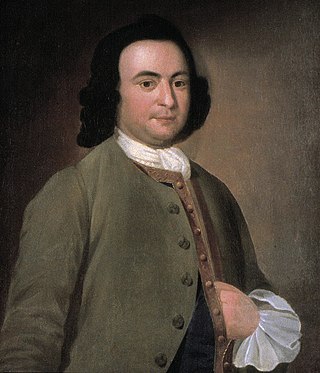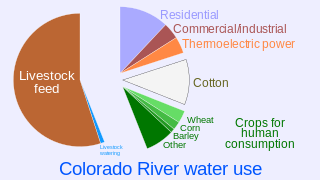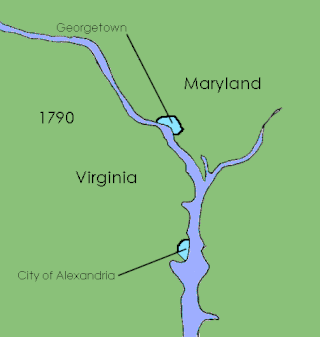
The Potomac River is a major river in the Mid-Atlantic region of the United States that flows from the Potomac Highlands in West Virginia to the Chesapeake Bay in Maryland. It is 405 miles (652 km) long, with a drainage area of 14,700 square miles (38,000 km2), and is the fourth-largest river along the East Coast of the United States and the 21st-largest in the United States. More than 5 million people live within its watershed.

Berkeley Springs is a town in, and the county seat of, Morgan County, West Virginia, United States, in the state's eastern panhandle. Berkeley Springs is also commonly used to refer to the area in and around the Town of Bath. In 1776, the Virginia Legislature incorporated a town around the springs and named it Bath. Since 1802, it has been referred to by the name of its original post office, Berkeley Springs. The population was 758 at the 2020 census. It is part of the Hagerstown–Martinsburg metropolitan area.

George Mason was an American planter, politician, Founding Father, and delegate to the U.S. Constitutional Convention in Philadelphia in 1787, where he was one of three delegates who refused to sign the Constitution. His writings, including substantial portions of the Fairfax Resolves of 1774, the Virginia Declaration of Rights of 1776, and his Objections to this Constitution of Government (1787) opposing ratification, have exercised a significant influence on American political thought and events. The Virginia Declaration of Rights, which Mason principally authored, served as a basis for the United States Bill of Rights, of which he has been deemed a father.

The Northern Neck is the northernmost of three peninsulas on the western shore of the Chesapeake Bay in the Commonwealth of Virginia. The Potomac River forms the northern boundary of the peninsula; the Rappahannock River demarcates it on the south. The land between these rivers was formed into Northumberland County in 1648, prior to the creation of Westmoreland County and Lancaster County.
Riparian water rights is a system for allocating water among those who possess land along its path. It has its origins in English common law. Riparian water rights exist in many jurisdictions with a common law heritage, such as Canada, Australia, New Zealand, and states in the eastern United States.
Water right in water law is the right of a user to use water from a water source, e.g., a river, stream, pond or source of groundwater. In areas with plentiful water and few users, such systems are generally not complicated or contentious. In other areas, especially arid areas where irrigation is practiced, such systems are often the source of conflict, both legal and physical. Some systems treat surface water and ground water in the same manner, while others use different principles for each.
Colonel Stevens Thomson Mason was an American lawyer, military officer and planter who served in the Continental Army during the Revolutionary War. Mason was also a delegate in the Virginia General Assembly and a Republican U.S. Senator from 1794 to 1803.

Fairfax Stone Historical Monument State Park is a West Virginia state park commemorating the Fairfax Stone, a surveyor's marker and boundary stone at the source of the North Branch of the Potomac River. The original stone was placed on October 23, 1746 to settle a boundary dispute between Thomas Fairfax, 6th Lord Fairfax of Cameron and the Privy Council of Great Britain concerning the Northern Neck of Virginia. It determined the proprietorship and boundaries of a large tract of mostly unsurveyed land in the British colonies of Maryland and Virginia.
The Potomac Highlands of West Virginia centers on five West Virginian counties in the upper Potomac River watershed in the western portion of the state's Eastern Panhandle, bordering Maryland and Virginia. Because of geographical proximity, similar topography and landscapes, and shared culture and history, the Potomac Highlands region also includes Pocahontas, Randolph, and Tucker counties, even though they are in the Monongahela River or New River watersheds and not that of the Potomac River.
Navigable servitude is a doctrine in United States constitutional law that gives the federal government the right to regulate navigable waterways as an extension of the Commerce Clause in Article I, Section 8 of the constitution. It is also sometimes called federal navigational servitude.

The Mount Vernon Conference was a meeting of delegates from Virginia and Maryland held at Mount Vernon on March 21–28, 1785, to discuss navigational rights in the states' common waterways. On March 28, 1785, the group drew up a thirteen-point proposal to govern the rights of both states on the Potomac River, Pocomoke River, and Chesapeake Bay. Known as the Mount Vernon Compact and formally titled as the Compact of 1785, this agreement not only covered tidewater navigation but also extended to issues such as toll duties, commerce regulations, fishing rights, and debt collection. Ratified by the legislature of both states, the compact helped set a precedent for later meetings between states for discussions into areas of mutual concern.
Head v. Amoskeag Mfg. Co., 113 U.S. 9 (1885), was a U.S. Supreme Court case considering whether a dam constructed on privately owned land served a public purpose and whether having the owner of the dam compensate any adjacent landowner was a legal form of eminent domain.
Fairfax's Devisee v. Hunter's Lessee, 11 U.S. 603 (1813), was a United States Supreme Court case arising out of the acquisition of lands originally granted by the British King Charles II in 1649 to Lord Fairfax in the Northern Neck and westward.

Water law in the United States refers to the Water resources law laws regulating water as a resource in the United States. Beyond issues common to all jurisdictions attempting to regulate water's uses, water law in the United States must contend with:
Maryland v. West Virginia, 217 U.S. 1 (1910), is a 9-to-0 ruling by the United States Supreme Court which held that the boundary between the American states of Maryland and West Virginia is the south bank of the North Branch Potomac River. The decision also affirmed criteria for adjudicating boundary disputes between states, which said that decisions should be based on the specific facts of the case, applying the principles of law and equity in such a way that least disturbs private rights and title to land.
Poole v. Fleeger, 36 U.S. 185 (1837), is a 7-to-0 ruling by the Supreme Court of the United States which held that the states of Kentucky and Tennessee had properly entered into an agreement establishing a mutual border between the two states. The plaintiffs in the case were granted title to property improperly conveyed by the state of Tennessee north of this border. In the ruling, the Supreme Court asserted the fundamental right of states and nations to establish their borders regardless of private contract, and made a fundamental statement about the rights of parties to object to a trial court ruling under the rules of civil procedure.
Wharton v. Wise, 153 U.S. 155 (1894), is a 9-to-0 ruling by the Supreme Court of the United States, which denied a citizen of the state of Maryland a writ of habeas corpus. The appellant, tried and convicted of illegally harvesting oysters from Pocomoke Sound in the Chesapeake Bay, had argued that his right to fish was protected by an interstate compact and that this compact also barred the state of Virginia from trying him. The Supreme Court disagreed on both counts.

The Occoquan River is a tributary of the Potomac River in Northern Virginia, where it serves as part of the boundary between Fairfax and Prince William counties. The river is a scenic area, and several local high schools and colleges use the river for the sport of rowing.
Virginia v. Maryland, 540 U.S. 56 (2003), is a case in which the Supreme Court of the United States settled a dispute between the Commonwealth of Virginia and the State of Maryland regarding Virginia's riparian rights to the Potomac River. The Supreme Court held in a 7—2 decision that Maryland has no legal authority to regulate or prohibit Virginia and its political subdivisions from building and improving structures in the river and from drawing water from the river. The decision drew heavily on the Maryland–Virginia Compact of 1785, an agreement between the two states concerning navigational and riparian water rights along the Potomac River.

The District of Columbia was created in 1801 as the federal district of the United States, with territory previously held by the states of Maryland and Virginia ceded to the federal government of the United States for the purpose of creating its federal district, which would encompass the new national capital of the United States, the City of Washington. The district came into existence, with its own judges and marshals, through the District of Columbia Organic Act of 1801; previously it was the Territory of Columbia. According to specific language in the U.S. Constitution, it was 100 square miles (259 km2).










